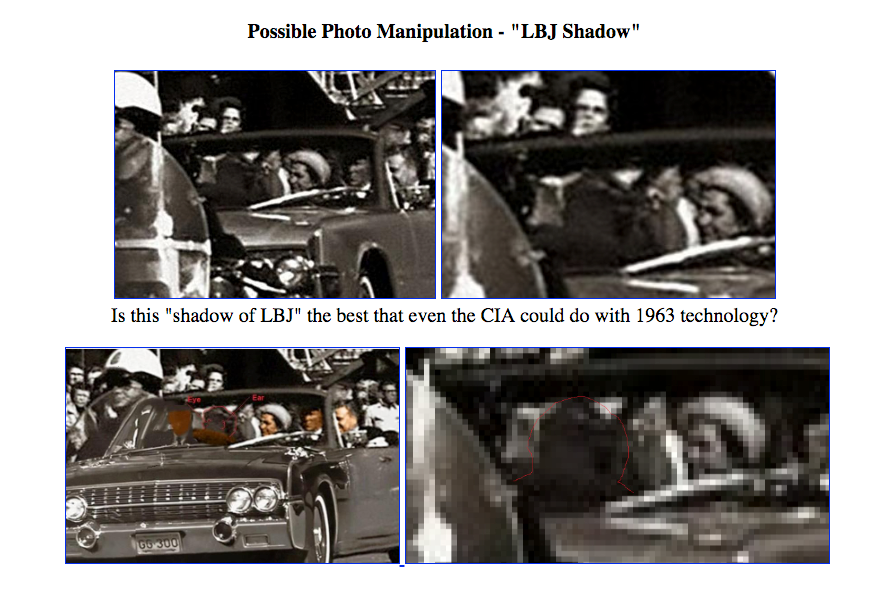
This is the continuation of the Real Truth behind John F. Kennedy's assassination.
You can find part 1 here,
In part 2 I will be adding
More Testimony including
A teacher and her friend's testimony whom the police stole a polaroid photo from.
A man working in a tower during the assassination who had an excellent view of who was there and who didn't belong.
Information regarding Lyndon B. Johnson, what his mistress had to say about his hate for JFK, and how he seemed to duck and be talking quietly to someone prior to the shootings.
These next two interesting pieces of information were told to me by some excellent patriots on voat on TheAwakening board. Many thanks to them!
Short video reports involving the former mistress of LBJ, a video on concrete proof LBJ knew and proof that he ducked, demonstrating prior knowledge to shooting.
Another account of a mob member who came out and stated that he was the killer of JFK and gave his story in a deal for immunity.
A source in regards to the "Umbrella Man," and Ted Cruz's father.
What soviet intel reports
Fully sourced throughout with more sources at the end.
This is the eye witness account of Jean Hill, a Dallas Schoolteacher.
Her account matches many other witnesses' testimony.
On 22nd November, 1963, Jean Hill, a Dallas schoolteacher, watched the motorcade of President John F. Kennedy from the grassy knoll facing the Texas School Depository Building. Hill and her friend, Mary Moorman were only a few feet away from President John F. Kennedy when he was shot. Hill thought the shots had come from behind her on the grassy knoll and as soon as the firing stopped she ran towards the wooden fence in an attempt to find the gunman. However, Hill was arrested by two policemen and taken into custody.
The vast majority of witnesses in the Dealey Plaza on that day claimed that shots came from two directions: the Texas Book Depository and the Grassy Knoll. The behaviour of the police to the shooting is also very interesting. Film of the Dealey Plaza shows that within seconds of the shots being fired several police charged up the grassy knoll. A few minutes later there were over 50 policemen searching the grassy knoll area and the railroad parking lot that was situated just behind it. This was a far larger number than went into the Texas Book Depository.
Grassy Knoll in Dealey Plaza
On 22nd November, 1963, Jean Hill, a Dallas schoolteacher, watched the motorcade of President John F. Kennedy from the grassy knoll facing the Texas School Depository Building. Hill and her friend, Mary Moorman were only a few feet away from President John F. Kennedy when he was shot. Hill thought the shots had come from behind her on the grassy knoll and as soon as the firing stopped she ran towards the wooden fence in an attempt to find the gunman. However, Hill was arrested by two policemen and taken into custody.
Assassination of John F. Kennedy Encyclopedia
In their book The Man on the Grassy Knoll, John R. Craig and Philip A. Rogers claimed that Charles Harrelson and Charles Rogers were the two gunman behind the picket fence on the Grassy Knoll. It was also claimed that Harrelson and Rogers were two of the tramps arrested in Dealey Plaza on 22nd November, 1963.
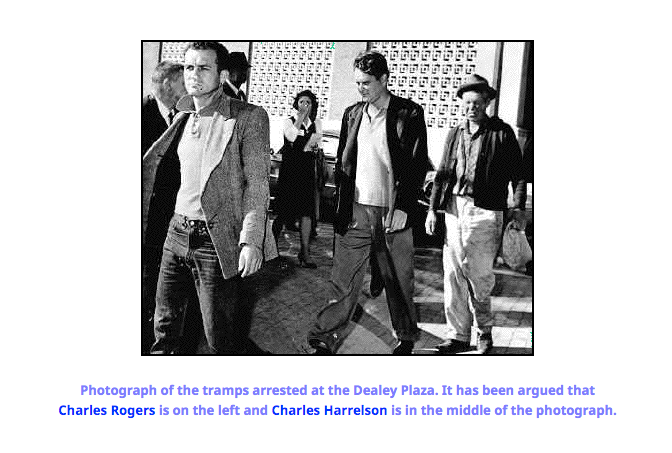
In 1978 the House Select Committee on Assassinations ordered a fresh investigation of Dallas Police records. In March of that year they discovered a trunk that had been in the possession of the former intelligence director of the department. This included a dictabelt recording of transmissions by police on the day of the assassination. The House Select Committee on Assassinations commissioned two prominent acoustical experts (Dr. James Barger and Dr. Mark Weiss) to study the tape. They concluded that four shots were fired at President John F. Kennedy. The gap between the first and second shots was 1.66 seconds. The third shot took place 7.49 seconds later. The gap between this and the final shot was only 0.44 seconds. It was clear that the third and fourth shots could not have been fired from the same gun.
After establishing where the police motorcycle that made the recording was at the time of the shooting, Barger and Weiss concluded that "with a probability of 95% or better" the third shot was fired from the grassy knoll. They were even able to state that the firing position was behind the picket fence, eight feet west of the corner. This was the very spot where S. M. Holland had claimed he has seen a puff of smoke after he had heard shots on the day Kennedy was killed. It was also the same spot where Phillip Willis' photograph appeared to show, according to computer analysis, "an adult person" standing behind a fence.
According to Harold Feldman, Fifty One Witnesses: The Grassy Knoll 1965,
Findings show there were more witnesses hearing the shots from the grassy knoll rather than any other area brought up by the Warren Commission.
More than half of all recorded witnesses agree. What follows is the result of a survey of the 121 witnesses to the assassination of President Kennedy whose statements are registered in the twenty-six volumes appended to the Warren Report. On the question of where the shots that killed the President came from, 38 could give no clear opinion and 32 thought they came from the Texas School Book Depository Building (TSBDB). Fifty-one held the shots sounded as if the came from west of the Depository, the area of the grassy knoll on Elm Street, the area directly on the right of the President's car when the bullets struck...
The Commission, failing to change the memories of witnesses, dismisses them with a wave of the hand. "No credible evidence," says its Report, "suggests that the shots were fired from the railroad bridge over the Triple Underpass, the nearby railroad yards or any place other than the Texas School Book Depository".
No credible evidence! It is clear how the Commission reached this absurd conclusion. Once it was committed to the thesis that there could be only one assassin and no accomplices, it readily accepted the clues pointing to Lee Oswald in the TSBDB. Now that the assassin and his place were identified, it became "incredible" that any other assassin or any other source of shots could exist. Ergo, any evidence that there was another assassin and another shot source is not "credible."
In what other murder case would the testimony of 51 sworn and many other unheard witnesses be dismissed so cavalierly as "no credible evidence"?
We submit, on the contrary, that the earwitness evidence is quite credible. Taken together with the ballistic and medical evidence analyzed by Mr. Salandria, it is not only credible; it is convincing. There was at least one other assassin firing at President Kennedy from the vicinity of the grassy knoll.
Jean Hill's statement made to the Dallas Police Dept. on November 22, 1963
Jean Hill
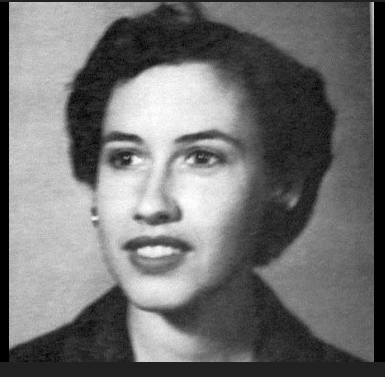
Mary Moorman started to take a picture. We were looking at the president and Jackie in the back seat... Just as the president looked up two shots rang out and I saw the president grab his chest and fell forward across Jackie's lap... There was an instant pause between two shots and the motorcade seemingly halted for an instant. Three or four more shots rang out and the motorcade sped away. I saw some men in plain clothes shooting back but everything was a blur and Mary was pulling on my leg saying "Get down they're shooting".
Jean left, Mary right frame 298 Zapruder film
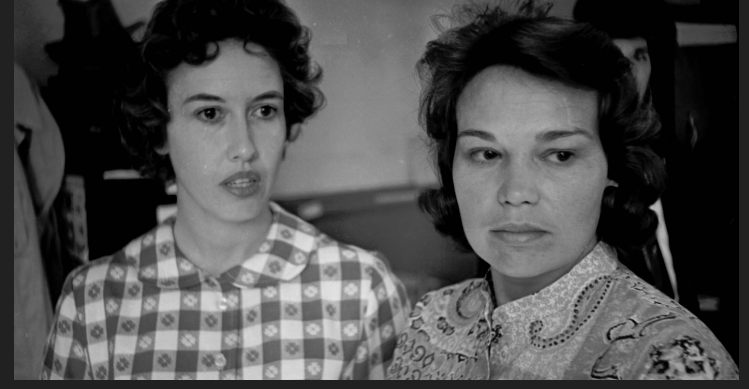
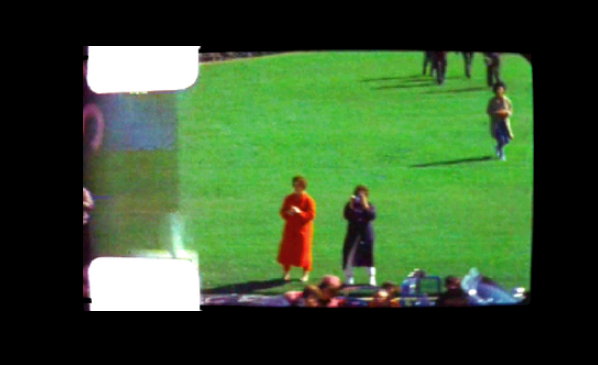
It is important to note that Jim Featherston who worked for the Dallas Times Herald at that time in 1963 according to him he had asked for the photo Hill took of the President falling into Jackie's lap. Hill's story differed from Featherston in that she claimed he took it then she felt forced into being led to the courtroom pressroom where Featherston wouldn't allow them to leave.
Featherston claims it was the deputy sheriff who found out he had two eyewitnesses and didn't want them leaving until they were questioned by law enforcement and that he, Featherston was simply relaying the deputy sheriff's message.
There seemed to be bad blood between both Hill and Geatherston, nonetheless her testimony in front of the Warren Commission was as follows;
Arlen Specter: Did you have any conscious impression of where the second shot came from?
Jean Hill: No.
Arlen Specter: Any conscious impression of where this third shot came from?
Jean Hill: Not any different from any of them. I thought it was just people shooting from the knoll - I did think there was more than one person shooting.
Arlen Specter: You did think there was more than one person shooting?
Jean Hill: Yes, sir.
Arlen Specter: What made you think that?
Jean Hill: The way the 'gun report sounded and the difference in the way they were fired-the timing.
Arlen Specter: What was your impression as to the source of the second group of shots which you have described as the fourth, perhaps the fifth, and perhaps the sixth shot?
Jean Hill: Well, nothing, except that I thought that they were fired by someone else.
Arlen Specter: And did you have any idea where they were coming from?
Jean Hill: No; as I said, I thought they were coming from the general direction of that knoll.
Mark Lane, Rush to Judgment (1966)
Mary Ann Moorman, an eyewitness to the assassination equipped with a Polaroid camera, was positioned in a strategic location in Dealey Plaza. She was standing with her friend, Jean Hill, across the street from and southwest of the Depository. Consequently, as she took a picture of the approaching motorcade the Book Depository formed the backdrop. Her camera was aimed, providentially, a trifle higher than the occasion demanded, and her photograph therefore contained a view of the sixth-floor of the building, including the alleged assassination window.
Mrs Moorman thus became a most important witness and her photograph an essential part of the evidence. Her presence at the scene and the fact that she did take the picture were vouched for by Mrs Hill when she testified before a Commission attorney. An FBI report filed by two agents discloses that they both interviewed Mrs Moorman on November 22.15 On that same day she signed an affidavit for the Dallas Sheriff's office. Deputy Sheriff John Wiseman submitted a report in which he said that he talked with Mrs Moorman that afternoon and that he took the picture from her. Wiseman stated that in examining the picture he could see the sixth-floor window from which the shots purportedly were fired."I took this picture to Chief Criminal Deputy Sheriff, Allan Sweatt, who later turned it over to Secret Service Officer Patterson," Wiseman said. A report submitted by Sweatt reveals that he also questioned Mrs Moorman and Mrs Hill on November 22 and that he received and examined the photograph. Sweatt said that "this picture was turned over to Secret Service Agent Patterson".
Since Mrs Moorman had used a Polaroid camera, the consequences were twofold: she was able to see the picture before it was taken from her by the police; she was not able to retain a negative. She told the FBI that the picture showed the Book Depository in the background, a fact confirmed by the two deputy sheriffs who also saw it.
Why was Mrs. Moorman's photograph and her name kept out of the Warren Commission? Was it too revealing of the truth?
Mrs Moorman was a witness with inordinately pertinent evidence to offer. Pictures of her in the act of photographing the motorcade appear in the volumes of evidence published by the Commission and in the Warren Commission Report itself. Yet the Report makes no mention of her or of her photograph; her name does not appear in the index to the Report. Although the Commission published many photographs, some of doubtful petinency it refused to publish the picture that possibility constituted the single most important item of evidence in establishing Oswald's innocence or guilt.
Do not All Thinking People find this Notable?
Jean Hill, speech (November, 1991)
That area (of the Dealey Plaza) is sloping so when Mary reached up to take the picture, we did get a picture of the School Book Depository. We knew that, because we had a Polaroid camera, we were going to have to be quick if we wanted to take more than one picture. So what we planned was, Mary would take the picture, I would pull it out of the camera, coat it with fixative and put it in my pocket. That way we could keep shooting. When the head shot came, Mary fell down and the film (i.e., the famous photograph) was still in the camera. When the motorcade came around, there were so many voters on the other side (of Elm Street) that I knew the President was never going to look at me, so I yelled, "Hey Mr. President, I want to take your picture!" Just then his hands came up and the shots started ringing out. Then, in half the time it takes for me to tell it, I looked across the street and I saw them shooting from the knoll. I did get the impression that day that there was more than one shooter, but I had the idea that the good guys and the bad guys were shooting at each other. I guess I was a victim of too much television, because I assumed that the good guys always shot at the bad guys. Mary was on the grass shouting, "Get down! Get down! They're shooting! They're shooting!" Nobody was moving and I looked up and saw this man, moving rather quickly in front of the School Book Depository toward the railroad tracks, heading west, toward the area where I had seen the man shooting on the knoll. So, I thought to myself, "This man is getting away. I've got to do something. I've got to catch him." I jumped out into the street. One of the motorcyclists was turning his motor, looking up and all around for the shooter, and he almost ran me over. It scared me so bad, I went back to get Mary to go with me. She was still down on the ground. I couldn't get her to go, so I left her. **I ran across and went up the hill. When I got there a hand came down on my shoulder, and it was a firm grip.
This man said, "You're coming with me." And I said, "No, I can't come with you, I have to get this man." I'm not very good at doing what I'm told. He showed me I.D. It said Secret Service.** It looked official to me. I tried to turn away from him and he said a second time, "You're going with me." At this point, a second man came and grabbed me from the other side, and they ran their hands through my pockets. They didn't say, "Do you have the picture? Which pocket?" They just ran their hands through my pockets and took it. They both held me up here (at the shoulder near the neck) someplace, where you could hurt somebody badly - and they told me, "Smile. Act like you're with your boyfriends." But I couldn't smile because it hurt too badly. And they said, "Here we go," each one holding me by a shoulder. They took me to the Records Building and we went up to a room on the fourth floor. There were two guys sitting there on the other side of a table looking out a window that overlooked "the killing zone," where you could see all of the goings on. You got the impression that they had been sitting there for a long time. They asked me what I had seen, and it became clear that they knew what I had seen. They asked me how many shots I had heard and I told them four to six. And they said, "No, you didn't. There were three shots. We have three bullets and that's all we're going to commit to now." I said, "Well, I know what I heard," and they told me, "What you heard were echoes. You would be very wise to keep your mouth shut." Well, I guess I've never been that wise. I know the difference between firecrackers, echoes, and gunshots. I'm the daughter of a game ranger, and my father took me shooting all my life.
Washington Post (11th November, 2000)
"She loved the fact that she was a witness to history," Mrs. Hill's daughter Jeanne Poorman told the Reuters news service.
"With the inordinate number of people connected with witnessing the assassination who died in suspicious circumstances, she was proud that she was a survivor," Poorman said of her mother.
Poorman said her mother thought the shots came from the grassy knoll nearby, not the book depository across the street, and ran to the area thinking she would be able to spot the gunman.
Instead of catching up with the gunman, Mrs. Hill said, she was seized by two men in police uniforms and briefly taken into custody despite telling them she thought the assassin was running from the knoll.
According to Wikipedia,
Hill stated that she received death threats and that the brake lines of her automobile were cut after the assassination. Hill apparently always thought of herself as a survivor after many of the other witnesses to the assassination died shortly after President Kennedy's death under what some considered to be mysterious circumstances. The assertions of the mysterious deaths connected with the assassination became a much more well known part of the popular conspiracy debate after appearing in the epilogue of the film Executive Action, which purports to show how a conspiracy could have been carried out. The film's epilogue states that "of 18 witnesses: all but two of whom died from unnatural causes within three years of the assassination". A voice-over then says that "an actuary of the British newspaper The Sunday Times calculated the probability that all these people who witnessed the assassination would die within that period of time to be 100,000 trillion to one."
S. M. Holland, The Warren Report: Part 2, CBS Television (26th June, 1967)
Just about the time that the parade turned on Elm Street, about where that truck is - that bus is now, there was a shot came from up-the upper end of the street. I couldn't say then, at that time, that it came from the Book Depository book
store.
But I knew that it came from the other end of the street, and the President slumped over forward like that and tried to raise his hand up. And Governor Connally, sitting in front of him on the right side of the car, tried to turn to his right and he was sitting so close to the door that he couldn't make it that-a-way, and he turned back like that with his arm out to the left. And about that time, the second shot was fired and it knocked him over forward and he slumped to the right, and I guess his wife pulled him over in her lap because he fell over in her lap.
And about that time, there was a third shot that wasn't nearly as loud as the two previous shots. It came from that picket fence, and then there was a fourth shot. The third and the fourth shots were almost simultaneously. But, the third shot wasn't nearly as loud as the two previous shots or the fourth shot. And I glanced over underneath that green tree and you see a - a little puff of smoke. It looked like a puff of steam or cigarette smoke. And the smoke was about - oh, eight or ten feet off the ground, and about fifteen feet this side of that tree.
Woody Woodland interviewed Ricky White, the son of Roscoe White, for the Manchester Magazine (September, 1990)
That (fatal shot) was fired by the man behind the stockade fence... Then it (the diary) states that he hands the rifle to a man to the right of him. And he has to hurl over the fence. He hurled over it, so therefore he jumped over the fence. There was a man that was evidently standing just right in front of him that was filming the motorcade because he talks about a military man that he had to hurl over the fence and obtain his film.
Anthony Summers, The Kennedy Conspiracy (1980)
A bit of a run down on Summers,
Summers has written extensively about the assassination of John F. Kennedy. He rejected the findings of the Warren Commission and instead claims that Kennedy was killed by a right-wing conspiracy that could have included Johnny Roselli, Carlos Marcello, Santos Trafficante, David Ferrie, Gerry Patrick Hemming, Guy Bannister, Sam Giancana and E.Howard Hunt.
One witness was in a better position than anyone else to observe suspicious activity by the fence at the top of the grassy knoll. This was railway worker Lee Bowers, perched in a signal box which commanded a unique view of the area behind the fence. Bowers said that, shortly before the shots were fired, he noticed two men standing near the fence.
One was "middle-aged" and "fairly heavyset," wearing a white shirt and dark trousers. The other was "mid-twenties in either a plaid shirt or plaid coat... these men were the only two strangers in the area. The others were workers that I knew." Bowers also said that when the shots were fired at the President "in the vicinity of where the two men I have described were, there was a flash of light, something I could not identify, but there was something which occurred which caught my eye in this immediate area on the embankment... a flash of light or smoke or something which caused me to feel that something out of the ordinary had occurred there." Lee Bowers was **questioned by the Warren Commission but was cut off in mid-sentence when he began describing the "something out of the ordinary" he had seen. **The interrogating lawyer changed the subject.
Wow!
A little background on Lee Bowers.
Lee Bowers was born in Dallas in 1925. He served in the US Navy during the Second World War. On his return to the United States he attended Hardin Simmons University and Southern Methodist University. After finishing his education Bowers he worked as a self-employed builder. Later he was employed as a signalman by the Union Terminal Company.
On 22nd November, 1963, Bowers was working in a high tower overlooking the Dealey Plaza in Dallas. He had a good view of the presidential motorcade and was able to tell the Warren Commission about the three cars that entered the forbidden area just before the assassination of John F. Kennedy.
Mark Lane interviewed Bowers for his book Rush to Judgment (1966): "At the time of the shooting, in the vicinity of where the two men I have described were, there was a flash of light or, as far as I am concerned, something I could not identify, but there was something which occurred which caught my eye in this immediate area on the embankment. Now, what this was, I could not state at that time and at this time I could not identify it, other than there was some unusual occurrence - a flash of light or smoke or something which caused me to feel like something out of the ordinary had occurred there."
Death threats for telling what he knew, then possibly drugged and ran of the road in 1966!
According to W. Penn Jones Jr, the editor of the Texas Midlothian Mirror , Bowers received death threats after giving evidence to the Warren Commission and Mark Lane.
On 9th August, 1966, Lee Bowers was killed when his car left the road and crashed into a concrete abutment in Midlothian, Texas. Robert J. Groden later reported "Lee Bowers was heading west here on highway sixty-seven heading from Midlothian down to Cleburne and according to an eyewitness he was driven off the road by a black car. Drove him into this bridge abutment. He didn't die immediately, he held on for four hours and during that time he was talking to the ambulance people and told them that he felt he had been drugged when he stopped for coffee back there a few miles in Midlothian."
Here was Lee Bowers was interview by Joseph A. Ball on behalf of the Warren Commission (2nd April, 1964),
Joseph A. Ball: Close to noon, did you make any observation of the area around between your tower and Elm Street?
Lee Bowers: Yes; because of the fact that the area had been covered by police for some 2 hours. Since approximately 10 o'clock in the morning traffic had been cut off into the area so that anyone moving around could actually be observed. Since I had worked there for a number of years I was familiar with most of the people who came in and out of the area.
Joseph A. Ball: Did you notice any cars around there?
Lee Bowers: Yes; there were three cars that came in during the time from around noon until the time of the shooting.
Joseph A. Ball: Came in where?
Lee Bowers: They came into the vicinity of the tower, which was at the extension of Elm Street, which runs in front of the School Depository, 'and which there is no way out. It is not a through street to anywhere.
Joseph A. Ball: There is parking area behind the School Depository, between that building and your tower?
Lee Bowers: Two or three railroad tracks and a small amount of parking area for the employees.
Joseph A. Ball: And the first came along that you noticed about what time of day ?
Lee Bowers: I do not recall the exact time, but I believe this was approximately 12:10, wouldn't be too far off.
Joseph A. Ball: And the car you noticed, when you noticed the car, where was it?
Lee Bowers: The car proceeded in front of the School Depository down across 2 or 3 tracks and circled the area in front of the tower, and to the west of the tower, and, as if he was searching for a way out, or was checking the area, and then proceeded back through the only way he could, the same outlet he came into.
Joseph A. Ball: The place where Elm dead ends?
Lee Bowers: That's right. Back in front of the School Depository was the only way he could get out. And I lost sight of him, I couldn't watch him.
Joseph A. Ball: What was the description of that car?
Lee Bowers: The first car was a 1959 Oldsmobile, blue and white station wagon with out-of-State license.
Joseph A. Ball: Do you know what State?
Lee Bowers: No; I do not. I would know it, I could identify it, I think, if I looked at a list.
Joseph A. Ball: And, it had something else, some bumper stickers?
Lee Bowers: Had a bumper sticker, one of which was a Goldwater sticker, and the other of which was of some scenic location, I think.
Joseph A. Ball: And, did you see another car?
Mr. BOWERS. Yes, some 15 minutes or so after this, at approximately 12 o'clock, 20 to 12... I guess 12:20 would be close to it, little time differential there... but there was another car which was a 1957 black Ford, with one male in it that seemed to have a mike or telephone or something that gave the appearance of that at least.
Joseph A. Ball: How could you tell that?
Lee Bowers: He was holding something up to his mouth with one hand and he was driving with the other, and gave that appearance. He was very close to the tower. I could see him as he proceeded around the area.
Joseph A. Ball: What kind of license did that have?
Lee Bowers: Had a Texas license.
Joseph A. Ball: What did it do as it came into the area, from what street?
Lee Bowers: Came in from the extension of Elm Street in front of the School Depository.
Joseph A. Ball: Did you see it leave?
Lee Bowers: Yes; after 3 or 4 minutes cruising around the area it departed the same way. He did probe a little further into the area than the first car.
Joseph A. Ball: Did you see another car?
Lee Bowers: Third car, which entered the area, which was some seven or nine minutes before the shooting, I believe was a 1961 or 1962 Chevrolet, four-door Impala, white, showed signs of being on the road. It was muddy up to the windows, bore a similar out-of-state license to the first car I observed, occupied also by one white male.
Joseph A. Ball: What did it do?
Lee Bowers: He spent a little more time in the area. He tried - he circled the area and probed one spot right at the tower in an attempt to get and was forced to back out some considerable distance, and slowly cruised down back
towards the front of the School Depository Building.
Joseph A. Ball: Then did he leave?
Lee Bowers: The last I saw of him he was pausing just about in - just above the assassination site.
Joseph A. Ball: Did the car park, or continue on or did you notice?
Lee Bowers: Whether it continued on at that very moment or whether it pulled up only a short distance, I couldn't tell. I was busy.
Joseph A. Ball: How long was this before the President's car passed there?
Lee Bowers: This last car? About 8 minutes.
Joseph A. Ball: Were you in a position where you could see the corner of Elm and Houston from the tower?
Lee Bowers: No; I could not see the corner of Elm and Houston. I could see the corner of Main and Houston as they came down and turned on, then I couldn't see it for about half a block, and after they passed the corner of Elm and Houston the car came in sight again.
Joseph A. Ball: You saw the President's car coming out the Houston Street from Main, did you?
Lee Bowers: Yes; I saw that.
Joseph A. Ball: Then you lost sight of it?
Lee Bowers: Right. For a moment.
Joseph A. Ball: Then you saw it again where?
Lee Bowers: It came in sight after it had turned the corner of Elm and Houston.
Joseph A. Ball: Did you hear anything?
Lee Bowers: I heard three shots. One, then a slight pause, then two very close together. Also reverberation from the shots.
Joseph A. Ball: And were you able to form an opinion as to the source of the sound or what direction it came from, I mean?
Lee Bowers: The sounds came either from up against the School Depository Building or near the mouth of the triple underpass.
Joseph A. Ball: Were you able to tell which?
Lee Bowers: No; I could not.
Numerous witnesses saw the vehicle that ran bowers off the road and into the bridge abutment.
Tosh Plumlee, interviewed on 6th April, 1992.
Q: Can you tell me exactly where you were standing in Dealey Plaza?
A: Yes, I can. We were standing approximately 150 feet east of the triple underpass on the south knoll up on the hill about 5 feet in line with the light posts.
Q: Could you tell how many shots were fired that day?
A: I recall myself, I'd say 4 or 5. That's what I recall. I've heard that there were more, I've heard that there were less.
Q: Could you tell the direction of those shots?
A: I couldn't tell the direction of the shots, but however, but my memory is that I feel a shot went over or head to the left of us. I'm familiar with gunfire. Also, when we left the area, we got a taste of gunpowder when we went over the railroad tracks which would have been south of the north grassy knoll.
Michael Kurtz, Crime of the Century: The Kennedy Assassination From a Historians Perspective (1982)
The huge, gaping hole in the right front of President Kennedy's head was almost certainly caused by an exploding bullet fired from the knoll. The rapid backward and leftward movement of Kennedy's head, as well as the backward and left-ward spray of brain tissue, skull bone, and blood are very strong indicators of a shot from the right front. Assuming that it is authentic, the acoustical tape actually recorded the sound of a knoll shot.
Eye and earwitness testimony furnishes further evidence of a shot from the knoll. Almost three-quarters of the witnesses who testified heard shots from the knoll during the shooting, and three people saw a flash of light there. Five witnesses smelled gunpowder in the knoll area. A witness saw a man fleeing the knoll immediately after the shooting, and two law enforcement officials encountered phony "Secret Service" men in the parking lot behind the knoll within minutes after the gunfire.
An assassin with even the slightest concern with making a successful escape would hardly have selected the sixth floor of the Depository Building for his firing site. He would have been trapped on an upper floor of the building. His only means of escape would have been to descend six flights of stairs and then weave his way through the crowd of spectators and police to freedom.
The Grassy Knoll, on the other hand, provided a natural and ideal sniper's position. The six-foot-high wooden fence and the abundance of shrubbery concealed him from the crowd, yet gave him an undisturbed line of fire at the president. The parking lot right behind the knoll gave him quick access to a getaway vehicle.
Here are some interesting notes pointed out by other Patriots on TheAwakening board found on Voat.
One Patriot, I'll refer to him as LP, states,
Patriot, LBJ passed a note stating they prove that Oswald was the lone shooter. now if you have no idea, would you not want the investigation to find all of those involved ? The night before the assassination, LBJ told his mistress that after tomorrow he would no longer have to worry about that SOB embarrassing him again. MSM called the person that shot Oswald Jack Ruby, his real name was Jack Rubenstein. The physician at Parkland Hospital ER noted a small entry wound on JFK neck , showing the bullet entered from the front. clearly showing we have a second shooter, Black Ops is know for triangulated fire, three shooters on what they consider a HVT, to ensure success. I suspect the building to JFKs left as they made the right turn to head to the book Depository Building would be a good placement for shooter number three, Oswald being number 1, shooter 2 by grassy knoll , and shooter number 3 at location I suspect, they all would have good vantage points and time to make the shoots. Number 3 is speculation.
Then stated,
No I never forgot and we want the real answers and Justice for JFK also. many of us always suspected LBJ but had no proof. but we started digging and kept on digging.
On JFK Truth is stated,
LBJ Ducked Before First Shot at JFK
Why can't we see LBJ?
Secret Service Agent Youngblood and the driver were in the front seat
:LBJ should have been visible, sitting next to Lady Bird
Left photo (from years before): LBJ often sat up high to be visible to voters.
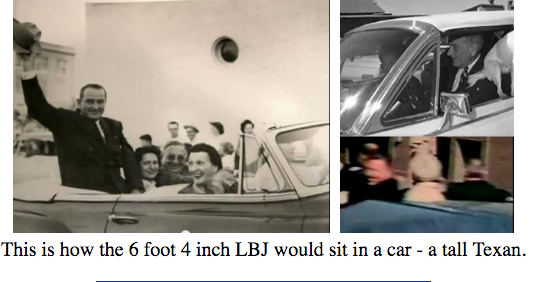


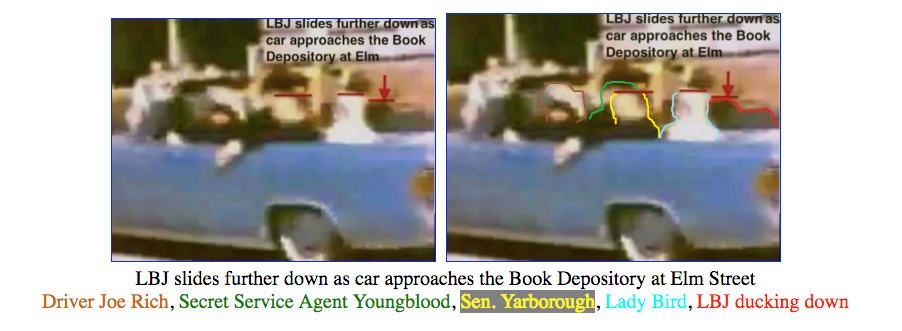
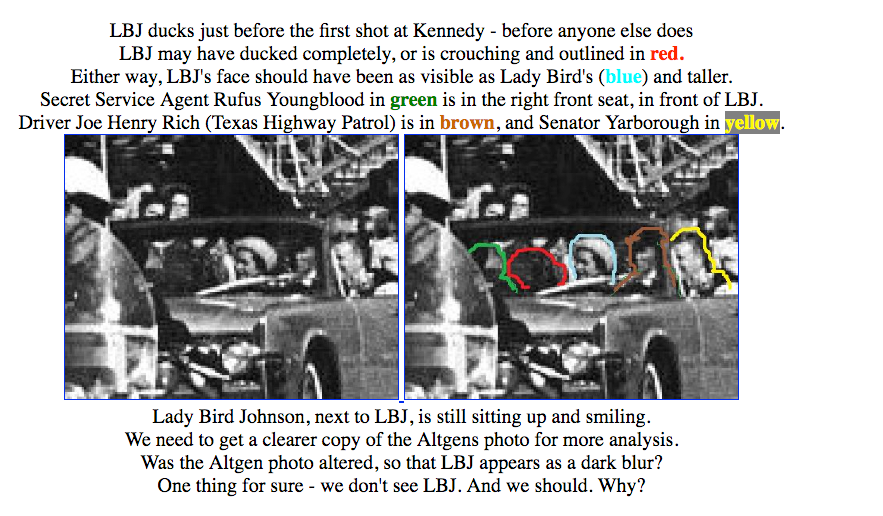
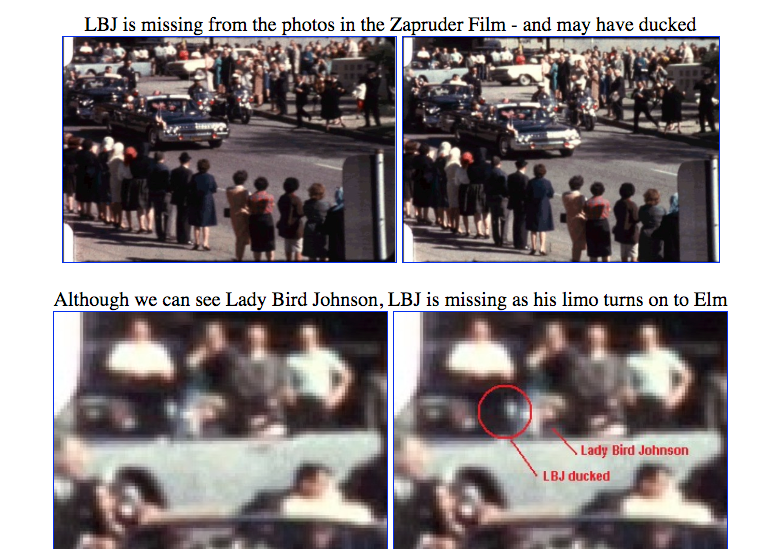


This video is very interesting, just under 15 min.
Kennedy Assassination: Proof LBJ Knew
JFK Assassination Concrete Proof of Conspiracy
Proof LBJ Ducked
"...There is the well-publicized story of Agent Rufus Youngblood, who reportedly threw himself on top of Vice President Johnson after the shooting began in Dealey Plaza.... Johnson, in a statement to the Warren Commission, mentioned the incident:
I was startled by a sharp report or explosion, but I had no time to speculate as to its origin because Agent Youngblood turned in a flash, immediately after the first explosion, hitting me on the shoulder, and shouted to all of us in the back seat to get down. I was pushed down by Agent Youngblood. Almost in the same moment in which he hit or pushed me, he vaulted over the back seat and sat on me. I was bent over under the weight of Agent Youngblood's body, toward Mrs. Johnson and Senator Yarborough....
However, former Texas senator Ralph Yarborough, who was sitting beside Johnson that day, told this author:
'It just didn't happen.... It was a small car, Johnson was a big man, tall. His knees were up against his chin as it was. There was no room for that to happen.' Yarborough recalled that both Johnson and Youngblood ducked down as the shooting began and that Youngblood never left the front seat. Yarborough said Youngblood held a small walkie-talkie over the back of the car's seat and that he and Johnson both put their ears to the device. He added: 'They had it turned down real low. I couldn't hear what they were listening to.'"
Dallas Police Officer Billy Joe "B.J" Martin said that according to his fellow motorcycle cops "who were escorting [the Vice-Presidential car] he [LBJ] started ducking down in the car a good 30 or 40 seconds before the first shots were fired..." He said, in reflection upon the moments before the shooting, "our new president is either one jumpy son of a bitch or he knows something he's not telling about the Kennedy thing."
There is an interesting article that came out last year titled,
Soviets thought President Lyndon B. Johnson was behind Kennedy assassination: document
A couple of other Patriots were aware of the mob angle.
One Patriot I will refer to as TS states,
I read this a few years back: https://www.newsmax.com/Newsfront/john-kennedy-assassination-confession-mafia/2014/11/20/id/608736/
I saw the video of the shot, and what happened before the shot.
The secret service agents that should have sat on the side of the car was ordered to move away, and one of the agents was confused and probably did not understand why. I thought it was odd, and it scared me. Someone with a lot of power had obviously planed it out carefully, and they had assassinated one of the greatest men that have ever lived.
Here is part of what the newsmax article contains,
Mafia hit man James Files says in interviews first aired nationally on Newsmax TV Thursday night that he worked along with major mob figures and fired the shot that killed Kennedy from the grassy knoll at Dealey Plaza in Dallas.
Newsmax TV marked the occasion by airing the provocative premiere of the blockbuster documentary "I Killed JFK", featuring never-before-seen footage of Kennedy's confessed killer.
The documentary, produced by Hollywood’s Barry Katz, presents convincing forensic evidence supporting Files' contention that he, and not Lee Harvey Oswald, fired the fatal shot at America's 35th president.
"I squeezed off my round. I hit him and blew his head backward," Files said of the single shot he fired that fateful day.
"I Killed JFK" Executive Producer Barry Katz said: "Until now, no one has ever confessed to the murder of JFK, and most people still believe that Lee Harvey Oswald was the killer. After the world sees this special, I am confident that the greatest mystery of our generation will finally be solved."
According to the National Post,
Umbrella man
The most famous theory involving multiple gunmen centers on “Umbrella Man”: a figure seen mysteriously holding a black umbrella on the sunny day of Kennedy’s assassination. Some speculated that Umbrella Man had shot a poison dart into Kennedy’s neck, immobilizing him to allow for Oswald or others to deliver a kill-shot.
Oliver Stone’s conspiracy-fueling 1991 film “JFK” showed Umbrella Man sending signals to his fellow assassins.
I am now working on getting my notes regarding Jacqueline and some interesting connections of the Kennedy family to some influential individuals in history.
More sources,
https://allthatsinteresting.com/kennedy-assassination
https://spartacus-educational.com/JFKbowers.htm
https://www.newsmax.com/Newsfront/john-kennedy-assassination-confession-mafia/2014/11/20/id/608736/




